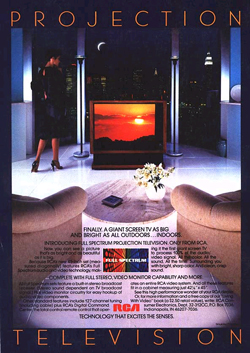|
Introduction of Projection Television
On the video side, television screens grew in size focusing on rear- and front-projection systems. These early, large screen television systems were not wonderful but did provide the needed segue for future systems to develop. These early big-screen television systems had a large footprint, were not very bright, and sometimes had serious convergence problems. They did not feature today's sophisticated circuits that do a better job of hiding the obvious scan lines created by the enlarged NTSC standard television picture. On top of that, annoying noise and defects in the picture magnify themselves on these larger screens. This is still true with even today's best HDTV television systems, the rule holding that garbage in is still garbage out. Zenith electronics develop a large-screen television in the early 1980's specifically designed for the Zenith customer who wanted to continue having an attractive wood console television set in their living room or family room. Zenith believed their console television customers would not be happy with a new, huge white blank screen looking back at them when the large-screen television was turned off, which other manufacturers were offering. This unique and one-of-a- kind Zenith rear-projection set actually hid the large television screen within a beautiful all-wood cabinet that was made in Zenith's cabinet factory. When the viewer pressed the "On" button on the set's remote control, a screen with its mirror would rise from under the all-wood top, the entire assembly pushed up by powerful hidden steel jack screws until the screen was fully viewable and locked into place. When the owner was finished watching selected programming and turned the set "Off," the screen would descend back into its beautiful wood cabinet. When back down, the wood top would drop back onto the unit, it looking like a liquor cabinet or stereo console. No one would ever know there was a large diagonal rear-projection television hiding within that beautiful cabinet.
RCA, in the 1980's, also created three-tube projection
sets that had smaller footprints than the larger units, while still
providing a reasonably large television screen surrounded by the traditional,
warm console-looking all wood cabinet (see on right.) The set provided
a 120-channel cable-ready analog tuner. With Zenith and RCA's
attention to the cabinet's design rather than the size of the screen,
large-screen television had come of age for the everyday consumer,
leaving behind the bulky-looking early rear- and front-projection
sets of the 70's. Other viewing technologies beyond the rear-projection screen were not available until the mid 1990's, starting with the experimental HDTV format that until recently was only shown in the broadcast environment. The HDTV format had been the result of years of research by a few manufacturers, one of them the engineers at Zenith Electronics Company located near Chicago, a company that had also invented other concepts such as FM stereo radio, employing me in the early 1980's. Zenith was also an early innovator of cable television decoder boxes for use by cable-TV providers that needed their premium channels easily scrambled for non-subscribers and descrambled for premium upgrades from the cable's Head End. The success and growth of these new HDTV systems as they stand today depend on the availability of a wide variety of cable related HDTV programming. This is critical if the new HDTV home-theatre system is to become as welcomed and common in the home as the new introduced console color television set enjoyed over forty years ago. For the HDTV format to succeed and not sit in limbo for years, it's important that there be adequate and impressive HDTV content available from cable providers with weekly, if not daily, concerts, live sporting events, and other hot topics. Currently HDTV programming has too many repeats (hidden under the word "Encore") with a limited amount of channels as too many greedy HDTV providers want too much money for their content. With cable companies hard pressed for cash and balking at the outlay of too much investment for too few HDTV customers, HDTV programming will continue to remain elusive, holding back the sales of HDTV television products. Without a change in marketing between the HDTV content providers and cable companies, sales of HDTV wide-screen televisions sets at their current stratospheric prices will not be successful in the quantities needed for manufacturers to pump out more product. This is the only way to create the lower prices that HDTV products need to reach the magic 15-20% ownership level in the marketplace, the magic point where new concepts take off and go mainstream. This magic marketing point where products take off is called the "S" curve. Its shape describes the slow growth of a product's acceptance at the beginning of its being marketed, then its fast growth as it's accepted by the consumer as a standard, and then its slow growth as the market becomes over-saturated with the product. In the next segment you'll discover what happens when
a format doesn't reach this historical important benchmark, measured
in the volume of product moved into the marketplace. Without sales
success, ideas die.
|
|
Index
|
